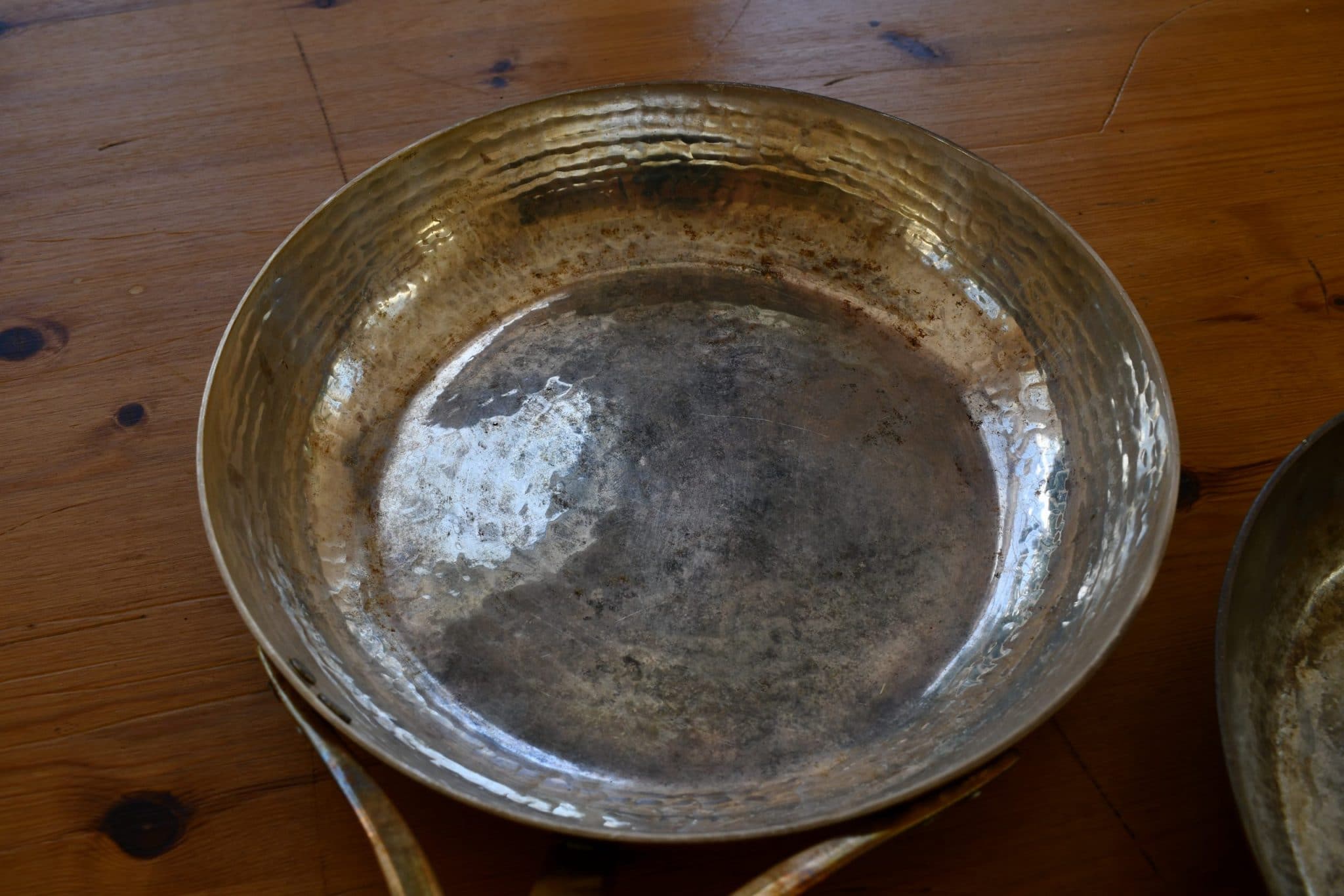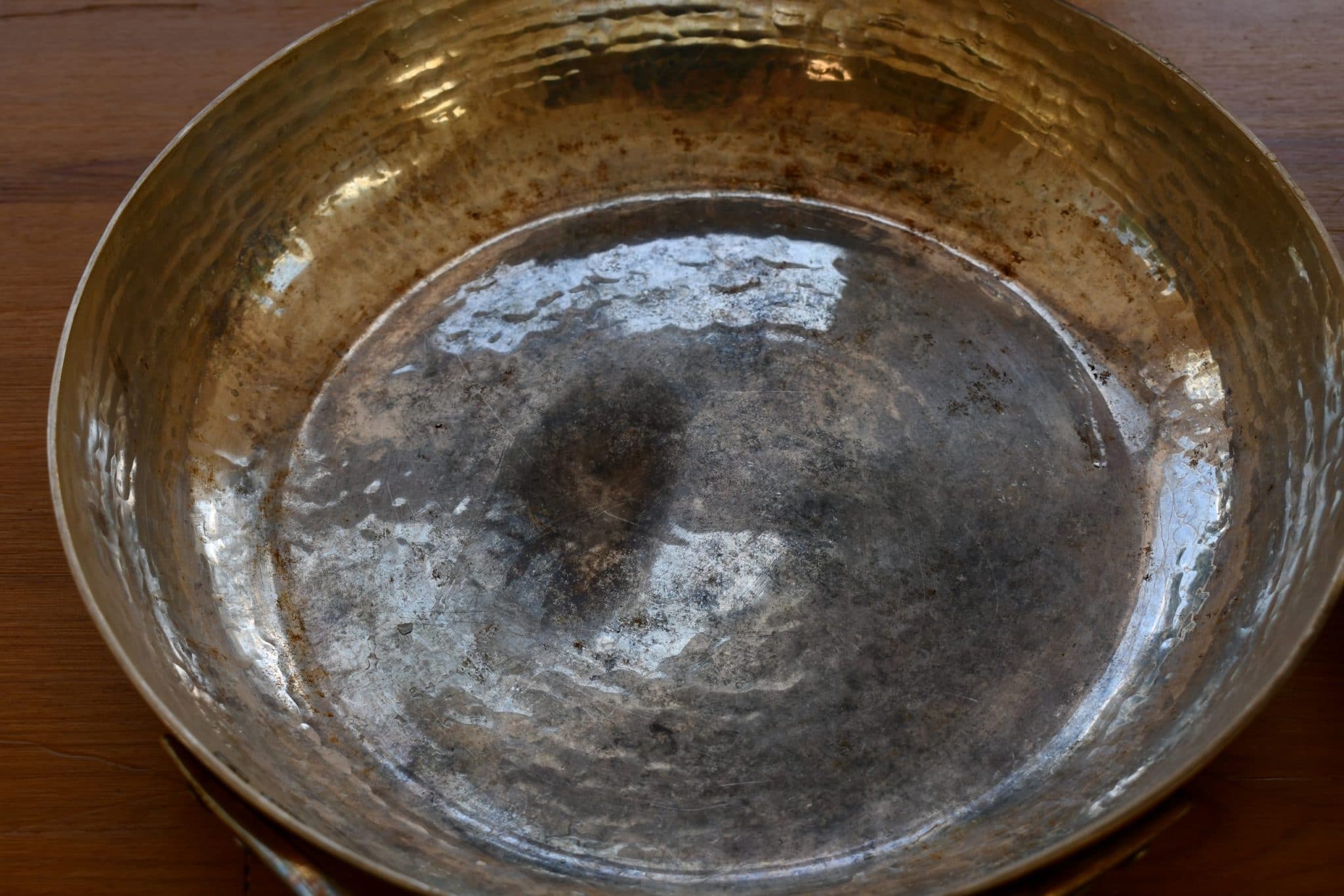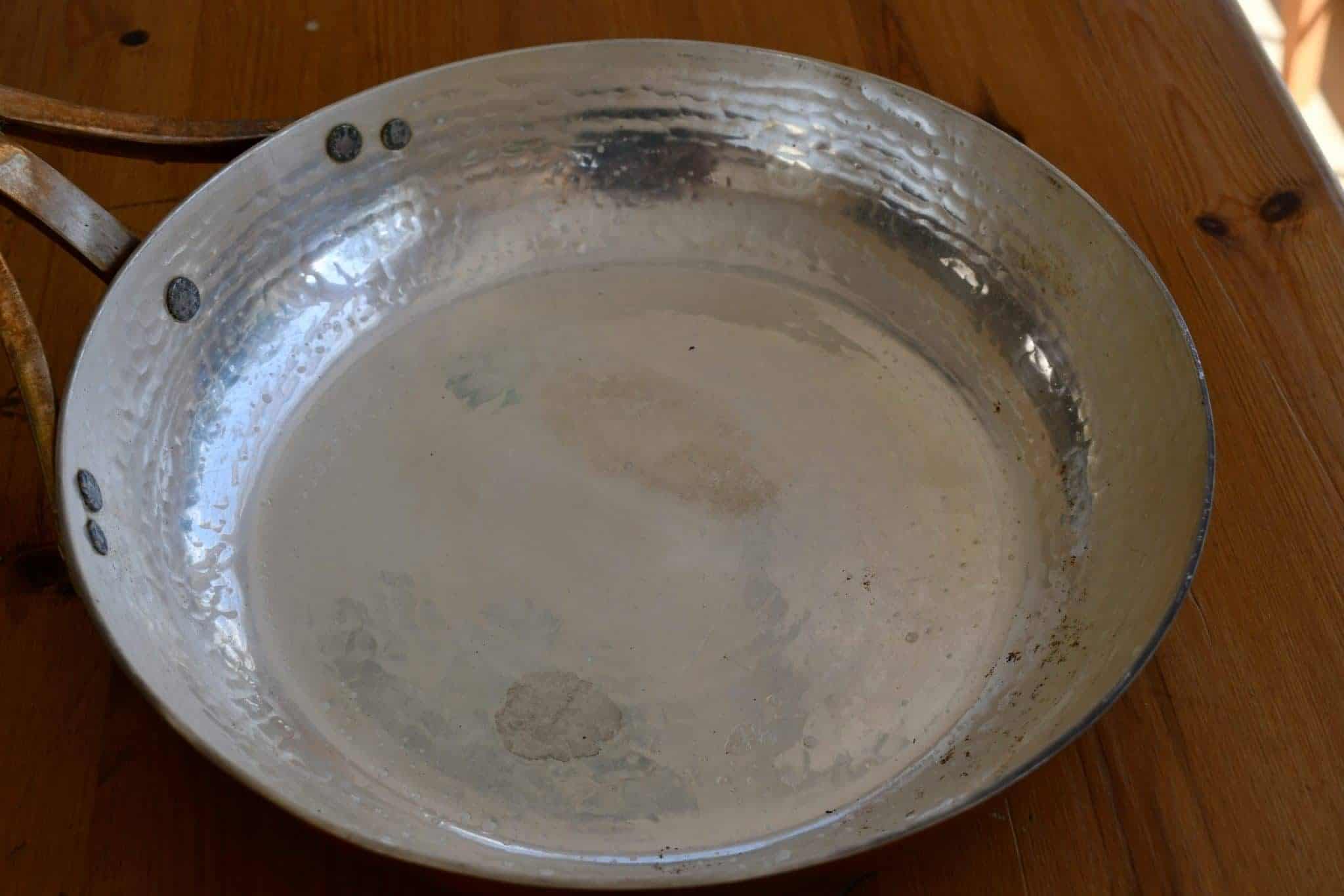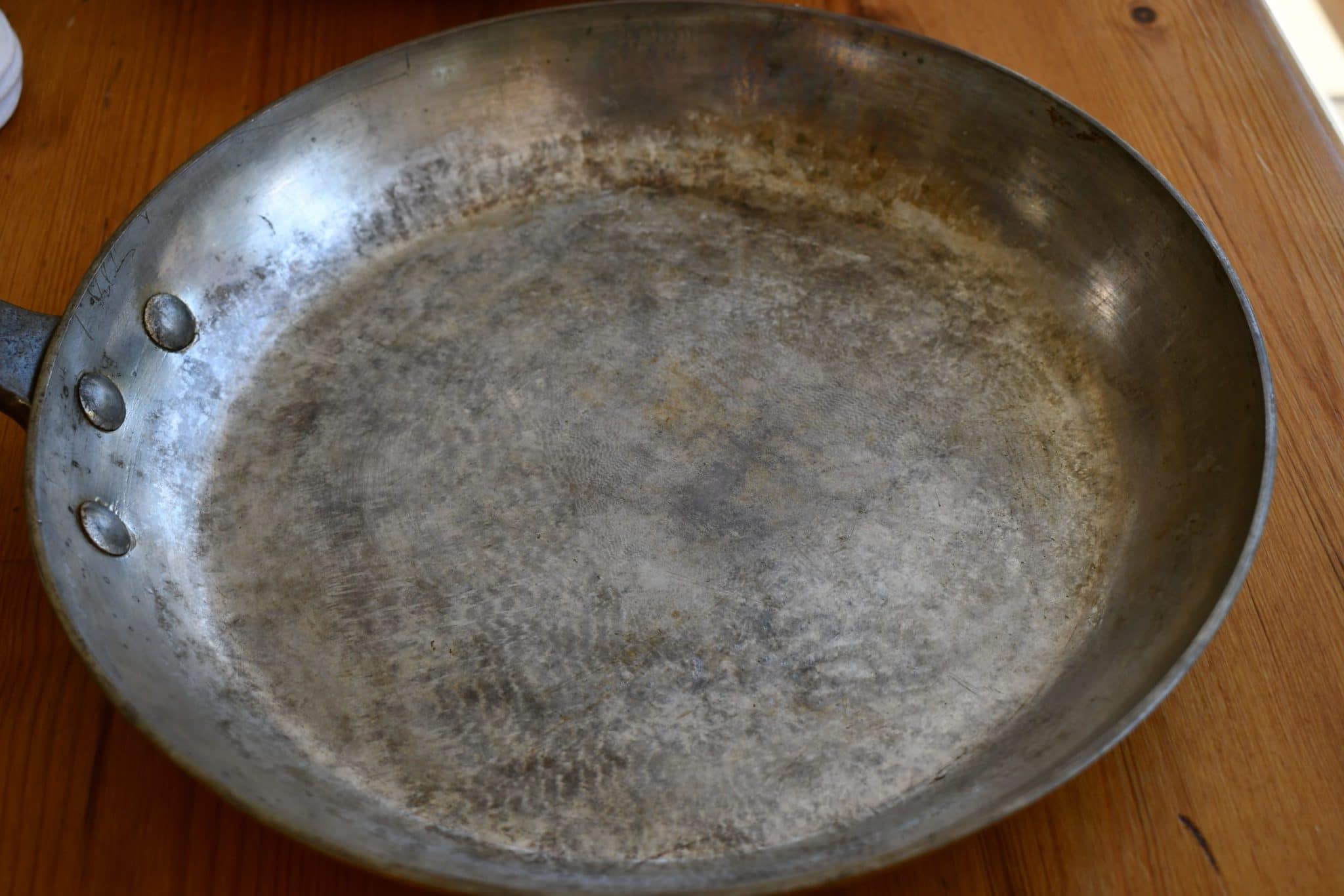To my eye, a silver lining looks a lot like tin, and I thought it might be useful to be able to tell the difference.
I have copper pans that I know are lined with silver, and a few vintage pieces that were sold to me as silver-lined. I have no reason to doubt the seller but I felt I needed a way to be sure about it before I write them up as such.
To my surprise, this isn’t a straightforward process. There are silver detection kits intended for antiques dealers and coin collectors and the like whose concern is to establish levels of purity and identify fakes. The kits use a strong solution of nitric acid, so strong that it is hazardous for skin contact, and the solution expires within a year. Furthermore, the test process is to scratch a piece of stone with the silver object to produce a few streaks of testable silver in order to avoid applying the test chemical directly to the object, presumably to avoid discoloring it. I’m hesitant to recommend a testing system that involves such harsh chemicals, and in any event it seemed impossible to produce a scratch sample from a concave pan surface.
Other home methods are designed to distinguish solid silver from silver plate. For example, one test is to place ice cubes on the “silver” piece and another baser metal and compare the speed at which an ice cube melts. Pure silver conducts heat excellently and an ice cube on a solid silver piece will melt more quickly than one set upon a different metal. But that won’t help me: the silver lining on a pan is only a few microns thick and I doubt there’d be a detectable difference in melt rates compared to a tinned pan.
None of the tests I found online seemed able to help me. I’m looking for a simple process to provoke some kind of visible reaction on silver but not on tin (or vice versa) — I don’t really care about purity or depth of plating or anything like that, just whether it’s silver or tin.
My solution was to try to adapt the guidance I found online to a surface wipe test using household chemicals. I’m not big on drama so I’m going to summarize my findings and recommendations here.
- Every reactive test I ran ended up marring the silver surface. In my opinion, it doesn’t harm the lining of the pan, but it dulls it. If you need to test the surface, pick a small area that is out of the way so any lingering discoloration won’t bother you.
- The most definitive test chemical was Bistro copper cleaner, which quickly produced dark tarnish on silver but not on tin. It left a subtle discoloration on the silver, so I suggest applying it to a small area and massaging it gently to stimulate the reaction.
- If your suspected silver-lined pan is tarnished, then silver dip will immediately brighten it, but will have no effect on tin. This is a potentially “safe” test but only works if the silver has tarnish to remove.
- To reduce the need for testing, cultivate an eye to distinguish an electroplated silver surface from a hand-wiped tin surface. At the end of this test I compare a clean silver-lined skillet next to a freshly retinned skillet so you can see the texture differences.
Ultimately, be careful testing a silver lining. If it’s tarnished, then silver dip is a great test chemical, as it’ll remove the tarnish but has no visible effect I could see on tin. But if the silver isn’t tarnished, then you may not see a reaction and you’ll have to try to provoke one. I didn’t find a way to do it that didn’t leave a discoloration that may be permanent. (You may of course have different results with different test chemicals.) But if you need to do this, I suggest applying some copper cleaner like Bistro, as the acids combined with the mild abrasives appear to stimulate a tarnish reaction on silver that will not occur on tin. Again, as above, keep in mind that my test of this method left a faint discoloration on the silver, so pick a small area in an inconspicuous place.
Read on if you’d like to see my tests and photos in more detail.
Tests and results
These are my test subjects: on the left, a known silver-lined skillet from Soy Turkiyë, and on the right, a known tin-lined skillet by Mauviel. They’ve both been used and have some seasoning and oxidation (aka tarnish) on them.

Side by side, they’re not that difficult to tell apart, even if you disregard the different handles and hammering. The silver looks brighter and more mirror-like next to the tin, but of course, this tin skillet is a daily-use pan for me and has picked up significantly more seasoning and oxidation than the silver one. But imagine seeing the silver pan on its own: tarnished and seasoned as it is, it could be mistaken for tin.


Test 1: White vinegar
My first test was to try to substitute the nitric acid component of a silver test kit with a weaker acid — acetic acid, aka white vinegar — to see if the silver reacted differently from the tin. I dripped some vinegar onto each surface and let it sit for a few minutes. As you can see below, neither the silver nor the tin reacted visibly to the vinegar. My guess is that acetic acid diluted into a household vinegar solution is nowhere near strong enough to provoke a reaction.


Test 2: Copper cleaner
My second test was Bistro copper cleaner composed of citric acid and fine-grained abrasives. I wiped a smear onto each surface and gave it a gentle rub. The results are much more obvious: the silver darkens significantly, while the tin seems to darken only slightly.


I washed the cleaner off with soap and water and you can see that the cleaner leaves an obvious visible layer of tarnish on the silver. The center area of the spot is yellower than the surrounding silver as well. The tin-lined pan shows no discoloration.


Here’s a closeup of the areas. I see significant reactivity on the silver lining and far less reactivity on the tin.


Test 3: Bleach
My third test was with Clorox bleach. According to an online source, silver “tarnishes quickly” in contact with bleach. Another source mentions that the effects can be permanent and can diminish the value of the silver piece. As you will see, this is correct.
Here’s the bleach in contact with the silver and tin. The silver appears to react immediately with the bleach while the tin does not.


After one minute, the tin continues not to react.


The silver’s reaction with the bleach was more significant than I expected. Even after I washed off the bleach, it left a discolored area — not the dark color of silver tarnish (such as the remnants of the copper cleaner test, still visible just above and to the left of the bleach patch), but a sort of dull pinkish cast. The tin, by comparison, looks unmarked by all tests so far.


Test 4: Silver cleaner
My fourth test was with silver dip, a liquid designed to remove tarnish instantly from silver. I dipped a cotton pad into the silver dip liquid and wiped it across the surface of each pan.
As you can see, the change to the silver lining is immediate. Silver dip is designed to remove tarnish, and lo and behold, it works quite well. However, I can still see traces of the copper cleaner (test 2) and the bleach (test 3).


Here’s the same test on tin. I didn’t bother to do a full wipe, as the silver dip had no visible effect on the tin.

This is a great test for silver, but only if the silver is tarnished. A brand new silver-lined pan or one that has been recently polished up for you may have no tarnish on it to react.
Test 5: Visual comparison of clean silver with fresh tin
At this stage in the test, I had a completely clean silver pan — the silver dip from test 4 had removed all the tarnish. Except for the marred area of the bleach test (and to a lesser extent from the copper cleaner test), the silver looks bright and new. I happen to have an unused Mauviel skillet that has been freshly retinned, and this creates an opportunity to compare two clean surfaces.
Below is the same Soy Turkiyë skillet, cleaned of tarnish from test 4, alongside another Mauviel tin-lined skillet that has not been used.

Take a close look at the surface of each pan. The Soy skillet is hammered, of course, so try to look past the rippled surface. The silver is almost perfectly smooth: there are faint scratches on the silver surface, but they’re there because I have used this pan for cooking and have cleaned it. By comparison, the lining on the tinned skillet shows subtle swipe marks. These swipe marks are not scratches but rather the actual surface texture of the tin.


If you are evaluating a piece of copper that purports to be lined with silver, take a good close look at the surface (or ask for a close-up photo to show the surface texture). Silver’s melting point is 1763°F (962°C), which makes it unsafe for a metalsmith to spread silver onto the copper pan by hand. Instead, the lining is electroplated: a chemical reaction drives silver atoms to adhere to the copper surface in a thin and perfectly even layer. This produces a lovely mirror-like finish without the telltale swirls and swipe marks of a hand-wiped tin lining.
(Baumalu is a special case. Their tin linings are exceptionally smooth thanks to their method of application: the pan is mounted and rotated while the tin is applied and spread. You will need to look very closely at the surface of a Baumalu pan to see the swipe marks.)
Summary of results
| Test | Results on silver | Results on tin | Notes |
| White vinegar (acetic acid) | No visible effect | No visible effect | Household white vinegar is probably not strong enough to react with either metal. |
| Bistro copper cleaner | Quick appearance of tarnish | No visible effect | The tarnish on silver was later removed with silver polish (test 4), but the abrasives may have marred the silver. Next time, rub more gently. |
| Bleach | Appearance of permanent dull pinkish blotch | No visible effect | Effects on silver may be permanent. I would not suggest using this test. |
| Silver dip | Instant tarnish removal | No visible effect | If your suspected silver piece is tarnished, then yes, this would work. |
| Visual comparison of clean silver and fresh tin | Silver has a mirror-like finish while tin shows swirls | Silver is plated in a thin even layer, while tin is hand-wiped and shows surface variations. | |
My recommendation
As I say at the start of this post, the chemical substance that produced a visible result with the least damage was the silver dip, but it only works if the silver is tarnished. If the pan looks bright and shiny, then your best option may be Bistro copper cleaner. I didn’t test other cleaners (and may come back and do that), so I can’t guarantee that every copper cleaner will do this. But I suspect that the same acids in copper cleaner that react to oxidation on the surface of copper also react to oxidation (that is, tarnish) on the surface of silver as well. The rubbing may be to blame for the appearance of the yellowish stain on the silver; when I try this again (and I have a specific future post in mind), I will try no rubbing or very light rubbing to see if it’s still effective.
What are your thoughts? If you work with silver, do you have better methods to test for it that aren’t destructive? I’d welcome your suggestions.


Hi, I have a few silver line items from Soy Turkiye and accidentally tarnished two of the items in a beautiful way. I have no clue how it happened. All I know is slow cooking oxtails caused the beautiful tarnish, which looks like a work of art. Might I send you the photos and you tell me what you think the cause is?
Hey Charles! I’d be happy to take a look. I’ll send you an email and you can send them to me. Thank you!